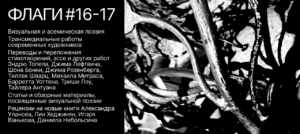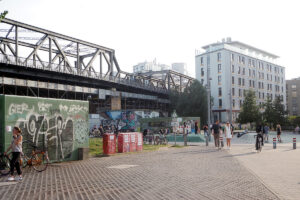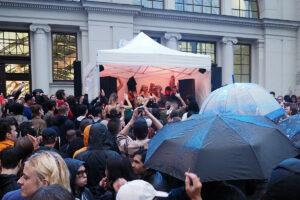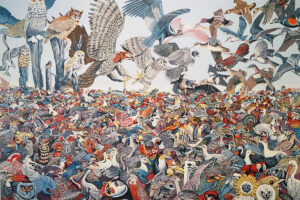>> Documents <<
February 11, 2024
Document 102: Note on Conduit
“Conduit” (“Kanal svyazi”)
trans. Arkadii Dragomoshchenko and Vladimir Feshchenko
Vsealizm (Moscow), 11 February 2024
From Moscow, for the second week in a row, comes a new translation of my work into Russian—here, “Conduit” into “Kanal svyazi”—in preparation for a bilingual edition to appear, one hopes, later this year. This work, brought forward over decades and across continents, truly stands as a conduit in the distressed conditions of communication, between the “territories of the East” and the rest of the world assuredly, but more generally as “what we live.” As I wrote on receiving word of this wonder:
There was a line from a Poets Theater play, Third Man by Carla Harryman, early 80s, spoken by Eileen Corder: “Go ahead, Moscow—I’m listening!” That was transgressive in the Reagan Era; in the current moment, one listens carefully to say the least. And now this translation of my poem “Conduit” has appeared—it is all about receiving messages, and not letting them stand as commonplaces or placeholders but as samples of “systematic distortion.” It’s about the “systematic distortion” of communication as communication itself, which we experience every day.
January 27, 2024
Document 101: Loyal to Many Flags
And loveliness?
Death has an understanding of it
Loyal to many flags
And is a silent ally of any country
Beset in its mortal heart
With immortal poetry.
—Laura Riding, “The Poet’s Corner
From Moscow, under conditions of global duress, comes the online publication of Flagii (Flags), double issue, numbers 16/17. Clicking on this link gets the issue, and for those without Russian, using Google translate or its equivalent yields a sense of the incredible poetic activity going on right now, with an intent to find “allies of any country.” Also breaching the gap are a number of texts with visual properties, in a selection introduced by Vladimir Feshchenko with work by Jackson Mac Low, Bernadette Mayer, Larry Eigner, Robert Grenier, Hannah Weiner, Rachel Blau du Plessis, Susan Howe, and myself (“Introduction to the Letter T”). I am also represented by an interview with Vladimir Koshelev and a translation of a section of Under Erasure by Lisa Kheresh, linked here, as well as the note on a little-known collage by Sylvia Plath that I wrote about on this site in 2010 (here), with commentary in Russian (here). It is not only a real honor to be included in this work but an example of what we should be doing now, connecting across the greatest distances possible, aspiring toward the horizon of “this time we are both.” … More
January 5, 2024
Entry 56: A Poetics of Encounter
A Poetics of Encounter:
Dialectic of Outside with the Beats
Read at “Can We Teach the Beat Generation?”
Discussion organized by Erik Mortenson and Tony Triglio
Session 228, 5 January 2024, 10:15–11:30 AM, Loews 3rd Fl.
Modern Language Association, Philadelphia“The transmission of poetry is a passion unlike any other.”
“I too have started a riot in the academy.”
In this note, I want to call up certain moments of encounter that were, as with the visual image of a “diamond thunderbolt” or dorje, immediate, double-faced, and bivalent: outward in the transmission of poetry, from the Beats or New Americans and others; and inward, toward self-formation and a long process of professionalizing within the Academy. In charting such a poetics of encounter, I draw from my presentations at the “decades” poetry conferences at University of Maine, Orono, in the 90s and 00s that I, in the company of a shifting assemblage of poet/critics, took part in. I connect these moments to Steven Belletto’s genealogy of three early moments of encounter between Beats and the Academy: Jack Kerouac’s intervention at a symposium sponsored by Brandeis University in New York, 1958; Diana Trilling’s reaction to Allen Ginsberg’s being given an “unofficial” reading at Columbia, that same year; and Gregory Corso’s rebuttal to a symposium on the Beats in Wagner Literary Review, 1959. These are part of series of breakthrough moments: the Gallery 6 reading, San Francisco, 1955; Ginsberg’s appearance in Time magazine, 1959; the Vancouver Poetry Conference, 1963; the Berkeley Poetry Conference, 1965. What makes the first three definitively “Beat” aligns with two concepts from my essay on Michael McClure: antagonism and holism. In challenging the Academy’s scholastic pedagogy—I often thought of the English Department in the 60s or 70s as a kind of monastery, corridors filled with the brethren nodding to each other under hooded robes—the Beats took a position Outside that was, at the same time, subject to everything—“Is there a world?,” Kerouac asked; “Man does not exist,” opined Corso. The nature of this encounter between an unregulated Outside and a self-regulating Inside points to a dialectic of the Academy whose stakes are not only literary, pointing toward our volume’s significance not only for Literary but University Studies. … More
December 31, 2023
Entry 55: Beginning Again and Again
Scaffolding Repetition: Gertrude Stein,
Language Writing, Electronic Dance Music (online here)
eLyra 22, special issue on “Poetics and Politics
of Repetition,” ed. Bruno Ministro, 25 December 2023 (online here)
Abstract: This essay takes up the critique of repetition in Gertrude Stein, her claim to have written a “continuous present” that “begins again and again” and “includes everything” versus her later qualification that repetition is always shifting in terms of “insistence” and “emphasis”. Even so, Stein focuses on the unfolding of the verbal material primarily in a linear fashion, though resonances and overtones abound. In Electronic Dance Music, from Detroit to Berlin techno, one finds more vertical layerings and “scaffolding”—a term taken from Soviet psychologist Lev Vygotsky—as a way of building up sonic elements in pleasurable and meaning-bearing ways. Using these two contrasting models of repetition, I read three language-centered poets—Ron Silliman, Leslie Scalapino, and Marjorie Welish—in terms of their complex forms of temporality in poetic form, seen in terms of Stein’s often repeated framework of “beginnings, middles, and ends”. I conclude with a discussion of ”vital movement” in the electronic dance music of Berlin DJ Ellen Allien.
Keywords: Modernism, avant-garde, repetition, language writing, poetry, electronic music, American, Berlin
September 16, 2023
Entry 52: Magnetic North (V)
Tuesday, June 20
Martin Eder, Elysium
Galerie EIGEN + ART
I.S. Kalter/Yana Tsegay
Mountains Gallery
On this day we determined to meet poet Donna Stonecipher and spend some unstructured time with her. We would begin with Galerie EIGEN + ART, last hold-out of the gallery wave that defined Auguststraße as emergent art district twenty years ago and representative of the Leipzig School, notably Neo Rauch. Most of the galleries that traversed the merger from East to West have left—most recently the conceptual gallery Barbara Wien—but EIGEN + ART kept its original location while branching out. (A search to find out what happened to the former Waschmachine gallery yields no trace but ads for the Whiteware brand of washing machine and “Hot German girl fucks dildo on Waschmachine,” on Xhamster). Such references intersect, in their vulgarity, with the work on view: a theatrical series of hyper-post-consumer-utopian-quasi-religious-fantasy tableaux by Martin Eder titled Elysium. As the gallery handout reads: “Since there are no blemishes, no disease, no suffering, and thus also no death in Elysium, the fresh moisture on the figures’ skin must come from the dew on Paradise’s meadows. ‘Dewy,’ as the beauty tutorials in the Internet call it.” The stretch from the conceptual rigor and ideology critique the gallery brought to Berlin, to the cynical avowal of kitsch grandstanding as having somewhat the same effect, defines the times we are in. Not much comment to make, so we proceed to a late lunch and walk a mile across Linienstraße to Pro QM Buchhandlung, nearby the always-beating heart of Left Berlin of Rosa-Luxemburg-Platz, the Volksbühne, Babylon Mitte, and the headquarters of Die Linke. After the surrealists’ calling as “specialists in revolt,” Pro QM sells books for “specialists in transformative urbanism,” from the psycho-geographical dérives of the situationists to current architectural studies and city guides, such as the one I brought back on Eisenhüttenstadt. It is home-in-exile on an intellectual plane that shows why we came here in the first place: to map the excitement of Berlin’s evolution as a city onto critical and creative projects. It is a source of thinking the city as one is within it.
September 2, 2023
Entry 51: Magnetic North (IV)
Friday, June 16
DB ICE 1040 Bergen auf Rügen > Berlin Hbf
54 Ebertystraße, Friedrichshain, Berlin
Carla Harryman
Ragna Berg
Florian Werner
Ellen Allien
Hamburger Bahnhof
Just about to get there; we have been away. Time crosses space, beginning in Rügen Island and ending in Berlin. Then we were advised to come and we would arrive. The party crowd is aware of its having a location in time and space, had been there for awhile—before we came. The party crowd at the Hamburger Bahnhof, celebrating the new director, a new orientation for art. As we come from a distance, the music invites us in, not yet there. On arrival it is there, an insistent pulse, meditative, cruising on horizontal, an endless plane of immanence, synced in time. He is coming soon, wrote Wittgenstein; he will be coming, he will have come. That must be the new director. Then he will have arrived. Gertrude Stein repeated the phrase, only with modulation. Ellen Allien is the legitimate appointee of the new director, hired to entertain and inspire the crowd, to be a work of art in herself. The party crowd is a work of art in itself, an instance of Gertrude Stein advancing in time. As the director himself had written, “The limits of my language mean the limits of my world“—that is the principle of new art at the Hamburger Bahnhof. It is raining, the crowd is moving slightly then more openly, Ellen Allien gestures to the sky, arms raised, rain is coming down. A steady pulse of the language of limits becomes an episode in time and space. We are not afraid of speaking.
A man coming.
Yes there is a great deal of use in a man coming but will he come at all if he does come will he come here.
How to you like it if he comes and look like that. Not at all later. Well anyway he does come and if he likes it he will come again.
Later when another man comes
He does not come.
Girls coming. There is no use in girls coming.
Well anyway he does come and if he likes it he will coming gain.Ellen Allien is the legitimate heir of Gertrude Stein. Nonsense, she pushes a button and there is a new orientation to the beat. Nonsense. Pulse, difference. Slight movements under an umbrella, the umbrellas are folded. We learn the new meaning to experience time and space, under the auspices of the new director, as an example of the new art. The art is coming all over with newness, like Gertrude Stein coming to Radcliffe, GIs arriving in the Bavarian Alps. The movement begins with a slight dancing, becomes more pronounced, is shared by many in the crowd. Finding a position in the middle, unable to really get a look at Ellen Allien, stepping back, her arms are raised with the beat. And a gigantic pause makes ensuing pulse more danceable, this is the basic grammar of techno. Nonsense. Now take a position a bit farther back, focus and click. On the pause that makes the pulse happen. Let us say what Ellen Allien teaches: electronic dance music teaches. She is the instructor of the moment, hired by the director, as an example of the new art. Her whole life is oriented toward this moment of instruction, in the form of a work of art, a way of being historical. This is the mandate of the Nationalgalerie der Gegenwart: to preserve the present as ethical obligation in the form of Ellen Allien and the crowd, moving under rain, skies now clearing, continuing as may be, a work of art.
July 29, 2023
Entry 48: Magnetic North (I)
Thursday, June 1
Icelandair DTW > KEF
Carla Harryman
The lonely imperative of travel, as if one is uniquely hailed. That is ideological, covered in pin feathers (illustration by Icelandic expatriate artist Eero above). It was an idea of mine to go north, to seek out the (scratch that). Over the long duration of our disease, the two survivors had lived on only home cooking and streaming Nordic crime series on Netflix. In the event, something was missing or being covered up—that is what is meant by “the body,” which kept us glued to our seats. The disused warehouse of narrative effects is where all bodies are kept, we would find, each waiting to be worked into the upcoming narrative. Not really—for years there had been a blank place in the narrative, now determined to be “magnetic north.” At some point in early winter it was decided, she suggested. Putting in place a plan, all would unfold but not necessarily the way it was predicted. I believe there is no drama here, only the outer shell of a fate that would be enacted, to be revealed. The crime genre is never really surprising, as we are gripped in our seats. The seats were booked on a newly refinanced Icelandair Boeing 737 Max, now returned to service, on a stopover in Iceland. The real thrill was seeming to go nowhere and ending up in a place we had imagined. Blank fields of lava unfold under the belly of the plane with special webcams for passengers. It will be early morning the next day when we arrive at our destination.
December 30, 2022
Entry 47: Liberating Gertrude Stein
“Liberation and the Historical Present:
Gertrude Stein @ Zero Hour”
In special half-issue on “Feeling in Time:
Radio Free Stein,” ed. Adam Frank
Textual Practice 36, no. 12 (December 2022)
To mark the end of 2022, and all its openings and reversals, the last thing I would do is indulge any form of triumphalism. The times do not permit it—the bare facts of pandemic and war, ideological gridlock and narrow avenues for hope are what we live. But the experience of this historical present recalls earlier moments; thus, during the longue durée of COVID sequestration, I took on a project of writing and researching Gertrude Stein at Zero Hour, her experience of exile under Occupation, in the larger context of theorizing the “end” of the war that was . . . not a new beginning but the punctual inception of the global order to come. This is a project that has compelled me over the past fifteen years, and will ultimately emerge as a book, one hopes.
The essay was originally framed for presentation at a meeting of EAM (European Avant-Garde and Modernist Studies), set for Leuven, Belgium, in September 2020. That meeting was canceled, so I organized, with Lauri Scheyer, a webinar colloquy in April 2021 with the title “Avant-Gardes @ Zero Hour.” The line-up of topics and presenters was exceptional, and many of the works found their way into print. Some time earlier, Adam Frank had been in contact about his Radio Free Stein project. In framing Stein at Zero Hour, I thought to take up her neglected play Yes Is for a Very Young Man, one of many significant post–1945 works produced in the immediate aftermath of the war. Stein was no Beckett, however; while she may have influenced Waiting for Godot, she did not have her finger on the pulse of the absurd. What she produced more of an historical afterthought, a retrospection or even a covering up of her earlier politics of “unreality” as tested by the experience of isolation and dread, and not a theatrical success. Coming to terms with Stein after 1945 turned out to be a major research project as well as detailed textual reading of Wars I Have Seen, the writing project by which she survived the war and “became historical,” on her own account. The larger argument is summarized in the abstract; for a limited time free downloads are available from the publisher (for both see below). … More
December 3, 2022
Entry 46: Theoretical Autobiography
Grand Piano TV episode 6: Barrett Watten
original recording, 17 November 2022
take 2: 27 November 2022
The name “theoretical biography” is intended to distinguish its territory from that of philosophy and physiology better than before, and to expand that biological approach which has been one-sidedly paraded and, in part, greatly exaggerated by the most recent school of psychology (Darwin, Spencer, Mach, Avenarius). Such a science would have to account for the mental life as a whole as it progresses from the birth of an individual to his death according to certain laws, just as it does for the coming into being and the passing away, and all the discrete phases in the life of a plant.
—Otto Weininger, Sex and Character (1903)
Introduction: method/technique
[Original recording] I’ve been thinking about how to represent The Grand Piano in this reading. One thought was simply to take a section and read it straight through with comments, build a structure out of it—like the concept of “reading out” I spoke about the other day at the Kelly Writers House event, using the text as a platform to make more text, more interpretation. I decided not to do that; rather, I decided to sample from the text and let the text do the work of commenting on itself. (If you want to experience the section that I would have read straight through, you can go to The Grand Piano part 4 and read that section.) I’ve done quite a lot of “reading out” of The Grand Piano; in Questions of Poetics there is a whole chapter on it. Even as the work was coming into focus, not yet complete, I was giving lectures on it—the whole process was entirely immodest. … More






















